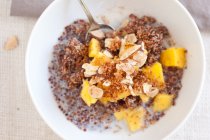 Cue the trumpets! I am pleased to present (doot dee doot) breakfast quinoa!
Cue the trumpets! I am pleased to present (doot dee doot) breakfast quinoa!
I came across Joy’s recipe for breakfast quinoa this week in perfect timing. Quinoa for breakfast sounded satisfying and delicious, and I happened to have all the ingredients on hand: mango, milk, apple sauce, almonds and coconut. The next morning, I woke up and cooked quinoa for breakfast.
Breakfast quinoa, it turns out, is just as filling as oatmeal and as easy to make, with endless variations.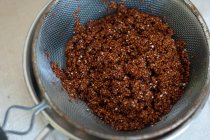 Quinoa has a nutty flavor that goes great with breakfast toppings, plus it’s a highly nutritious way to start the day. Quinoa is a complete protein that’s packed with vitamins and minerals.
Quinoa has a nutty flavor that goes great with breakfast toppings, plus it’s a highly nutritious way to start the day. Quinoa is a complete protein that’s packed with vitamins and minerals.
Breakfast quinoa is a perfect way to use up leftover quinoa, and you can easily make it a vegan meal if you use almond, coconut or soy milk instead of regular milk. I’m hooked!
To cook quinoa, measure out one cup of grains, pour into a colandar, and rinse them under water for a few minutes. Rinsing removes the bitter saponins coating the outside of the quinoa. Then, pour the rinsed quinoa into a pot and add two cups water (you’re going for a 1:2 ratio of quinoa and water).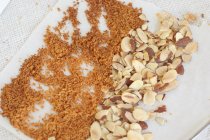 Bring to a boil, then cover and simmer for 15 minutes. Remove from heat, let sit for a few minutes, and fluff with a fork.
Bring to a boil, then cover and simmer for 15 minutes. Remove from heat, let sit for a few minutes, and fluff with a fork.
Some of the other breakfast quinoa recipes I’ve come across recommend cooking the quinoa with milk instead of water, or a combination of milk and water (e.g. this recipe on 101 Cookbooks). Emma at The Kitchn recommends cooking the quinoa with water, as usual, and then adding a cup of milk at the end and letting is cook down a bit. Both methods sound delicious, but I like using leftover quinoa for other recipes, so I cooked my quinoa with all water. I just poured milk into my bowl when I was ready to eat quinoa for breakfast.
Per Joy’s recommendation, I toasted sliced almonds and unsweetened coconut in the oven. It’s an unnecessary step if you’re in a hurry. Almonds and coconut are good, toasted or not!
Source: cookieandkate.com
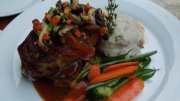








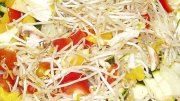
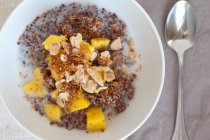
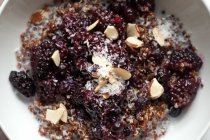















"Virgin" in the name of any oil refers to the fact that it comes from the first pressing or extraction of the oil from the source, in this case coconut.